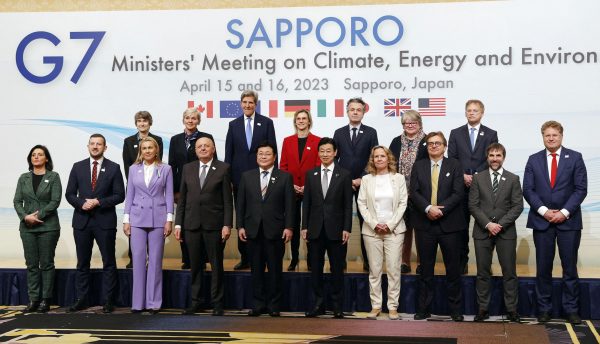Japan’s recalcitrant stance towards deep decarbonisation reveals a schism between its approach to the energy transition and that of the West. The schism has implications for decarbonisation in the developing economies of Asia. Japan’s stance on the clean energy transition risks locking Asia into fossil fuels for decades to come.
A gulf between Japan and other G7 members emerged on reducing greenhouse gas emissions from the power and road sectors.
The United Kingdom, Canada, France and Germany proposed 2030 as an explicit timeline for phasing out unabated coal-fired power plants but Japan resisted a deadline. Japan requested that hydrogen and ammonia be considered low-carbon solutions for power generation but European and US negotiators criticised the request. The United States, United Kingdom and European Union called for quantitative targets for electric vehicle adoption. Japan, whose auto industry has been under threat from the rise of electric vehicles, demurred.
While there were disagreements between the United States and European negotiators, the differences between Japan and the other G7 members stood out.
Japan has a fundamentally different approach to the energy transition compared to that of the West. Japanese officials have promoted the concept of ‘various pathways toward a common goal’ of net-zero by 2050 at the G7. The ‘various pathways’ concept is a confluence of two narratives espoused by Japan’s Ministry of Economy, Trade and Industry and domestic industrial interests.
The first narrative is that Japan’s geographic constraints mean that its energy needs are different and more challenging to meet than those of the West. Japan’s mountainous terrain, steep shorelines and dense population ostensibly make it difficult to scale up renewables.
The Japanese government has long emphasised the need to import low-cost fossil fuels from a range of trade partners — including crude oil from the Middle East and liquefied natural gas and coal from Australia. This dependency on fossil fuel imports became even more acute after the 2011 Fukushima nuclear disaster.
The second narrative is that Japan must ensure a secure supply of all energy sources, including fossil fuels and fossil-derived fuels. The Japanese government’s energy transition strategy aids incumbent industrial and energy players. The GX (‘Green Transformation’) Basic Policy unveiled by Prime Minister Fumio Kishida’s administration in February 2023 features blue hydrogen, ammonia co-firing, coal gasification, carbon capture and storage (CCS) and natural gas.
The GX plan is incongruent with Japan’s renewable energy potential and global energy trends. Japan has vast domestic solar and wind energy resources — enough to produce all of its electricity from offshore wind and solar for US$86–110 per megawatt hour. Globally, it is solar energy, with support from wind, that is growing the fastest. Around 400 gigawatts of new solar and wind capacity is projected to be added in 2023, and installed solar capacity will reach about 6 terawatts in 2030. Despite these opportunities and trends, Japan has doubled down on old energy systems.
The Japanese government extends these narratives to Asia’s developing countries, giving rise to its various pathways concept. According to this view, while Asian economies must lower emissions from their energy sectors, their energy profiles are different from those of Europe and the United States. Modest wind, a shortage of flat land and expected growth in energy demand are presented as constraints on developing Asia’s renewable energy potential.
Japan also claims Asia’s large fleet of coal plants is still young, suggesting that lowering emissions from thermal power with ammonia co-firing and CCS is an important part of the region’s energy transition. Most importantly, Japan’s government and industry intend to be the leading partners with developing Asian countries in the energy transition.
Japanese leaders have rolled out the diplomatic red carpet to open Asian energy markets to Japanese firms. Kishida’s government has spearheaded the Asia Energy Transition Initiative and the Asian Zero Emission Community. Bilateral energy agreements with Indonesia, the Philippines, Australia, Thailand and Vietnam have followed. Japan ranked first among G20 countries in international public financing for fossil fuel projects between 2019 and 2021.
The various pathways to net-zero narratives Japan espouses will not assist with the goal of limiting global warming to 1.5 degrees. The evidence suggests new coal technologies, ammonia co-firing and fossil fuel-derived hydrogen are costly and fail to achieve sufficient emissions reductions. The potential of hydrogen in the electricity sector remains uncertain and the prospects for CCS are even less optimistic.
This flawed strategy must be countered. Civil society groups have already united against Japan’s energy diplomacy in Asia. Activist shareholders have also pressured Japanese banks to limit support for new oil and gas development. But these groups need more firepower.
A more sustained empirical analysis of the claims that constitute Japan’s narratives, accompanied by persuasive business cases and realistic policy recommendations for fossil fuel phase-out and clean energy deployment, could lend these reform-minded groups the strength they need.
Walter James holds a PhD from Temple University and is former research fellow at Waseda University. He is the principal author of the Power Japan blog.


No observations on diplomatic devoirs? I believe the Japanese position bends sympathetically towards other Asian country positions, to remind everyone of the range of expressed needs globally.
Very helpful review – but you need to fix the headline!
You’re absolutely right – Countries like Indonesia, Philippines, Malaysia, to name a few, welcome Japanese energy diplomacy with open arms. These governments seem to be very happy to receive Japanese investments in energy infrastructure as well.
Hopefully I can explore this geopolitical dimension in another contribution. If you have further insights on this, feel free to let me know
Very useful article, thank you Walter. It seems that not even the Fukushima crisis was deep enough to bring about significant structural changes in Japan’s energy practice, policy and thinking. While Japan is a renewable energy technology leader on certain key fronts, it remains apparently conservative in other crucial areas. But let us keep the conversations going.